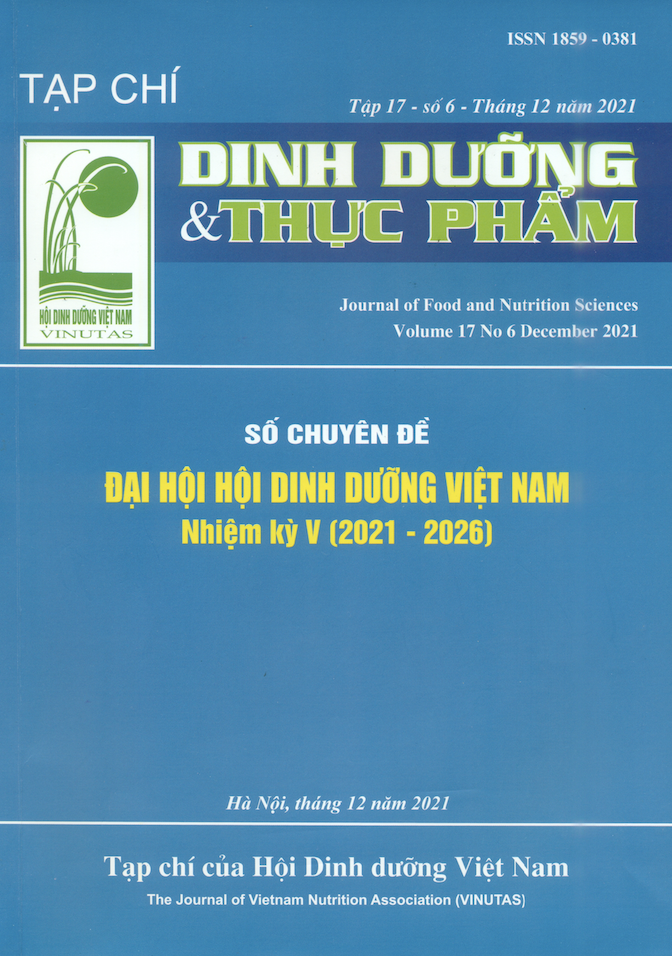Some dietary characteristics of patients with hepatitis treated at Hoa Binh General Hospital in 2020
Main Article Content
Abstract
A cross-sectional descriptive study on 102 subjects by interviewed questions and collected test results in medical records with the following objectives: Evaluation some dietary characteristics of hepatitis patients treated at Hoa Binh General Hospital 2020.
Results: The average value of dietary energy were 1852.0±525.7 Kacl/day; Protein were 67.8±23.3g/day; Lipid were 36.0±16.6g/day; Glucid were 315.2±94.3g/day. The aver age percentage of energy from Protein were 14.7±2.6%, from Lipid were 17.3±6.3% and predominately from Glucid were 68.2±7.9%. The percentage of subjects met energy, Protein, Lipid and Glucid requirements were 42.2%; 45.1%; 16.7% and 48.0%. The percentage of subjects met the requirements for minerals calcium, phosphorus, iron and zinc in the diet were 8.8%, respectively; 71.6%; 66.7% and 37.3%. The percentage of subjects met the requirements for vitamin A, vitamin B1, vitamin B2, vitamin C in the diet were 6.9%, respectively; 56.9%; 12.7% and 36.3%. Conclusion: Patients with hep atitis did not meet the recommended ratio of the needs of 3 energy-producing substances (P, L, G); vitamins (A, B1, B2, C) and minerals (Ca, P, Fe, Zn) are still quite high.
It is necessary to strengthen communication and individual nutrition counseling more often in clinical departments, especially disease groups at high risk of malnutrition.
Keywords
Hepatitis, diet, Hoa Binh General Hospital
Article Details
References
2. Vũ Bằng Đình (1985). Viêm gan virus. Nhà xuất bản Y học Hà Nội, trang 201-223
3. Phạm Song (2008). Những vấn đề cơ bản và mới về bệnh viêm gan do virus. Nhà xuất bản Y học Hà Nội, trang 109-213
4. Nguyễn Thị Kim Thư (2000). Diễn biến lâm sàng, rối loạn chức năng gan và mối liên quan với AFP trong bệnh viêm gan virus B, xơ gan và ung thư gan. Luận văn tốt nghiệp bác sĩ nội trú bệnh viện, Hà Nội
5. Amany M. Abdelhafez (2018). Assessment of Nutritional Status in Chronic Hepatic Patients at Ain Shams University Hospital, The Egyptian Journal of Community Medicine, 36(2), pp. 13-19.
6. Bộ Y tế (2007). Bảng thành phần hóa học thức ăn Việt Nam, Nhà xuất bản Y học
7. Chang Y, Liu QY and Zhang Q (2020). Role of nutritional status and nutri tional support in outcome of hepatitis B virus-associated acute-on-chronic liver failure, World J Gastroenterol, 26(29), pp. 4288-4294.
8. Ferreira L. G., Anastácio L. R. and Lima A. S. (2009). Desnutrição e in- adequação alimentar de pacientes aguardando transplante hepático, Revista Da Associação Médica Bra sileira, 55(4), pp. 389-393.
9. Hashemi kani A, Alavian S M and Es maillzadeh A (2013). Dietary Quality Indices and Biochemical Parameters Among Patients With Non Alcoholic Fatty Liver Disease (NAFLD), Hepa- titis Monthly, 13(7), pp. e10943.
10. Federico A., Dallio M. and Caprio G. (2017). Qualitative and Quantitative Evaluation of Dietary Intake in Patients with Non-Alcoholic Steatohepatitis, Nutrients, 9(10), pp. 1074-1081.
11. Da Silva H. E., Arendt B. M. and Noureldin S. A. (2014). A Cross-Sectional Study Assessing Dietary Intake and Physical Activity in Canadian Patients with Nonalcoholic Fatty Liv er Disease vs Healthy Controls, Jour- nal of the Academy of Nutrition and Dietetics, 114(8), pp. 1181–1194.
12. Yang Z., Wu J. and Li X. (2019). Association between dietary iron in take and the prevalence of nonalcoholic fatty liver disease, Medicine, 98(43), pp. e17613.
13. Gottschall C. B. A. (2015). Nutritional status and dietary intake in non-cirrhotic adult chronic hepatitis c patients, Arquivos de gastroentero logia, 52(3), pp. 204-209.
14. Peres W. A. F., Chaves G. V. and Gonçalves J. C. S. (2011). Vitamin A deficiency in patients with hepatitis C virus-related chronic liver disease, British Journal of Nutrition, 106(11), pp. 1724–1731.


